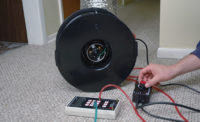If you want to get a heated discussion started among HVAC professionals, start asking about the practices used in duct sizing. There is a passion among those in the HVAC industry in regards to the methods they use to determine what size ducts to install.
These methods are often traditions passed down over decades, similar to what was passed down to me when I started installing many years ago. If you question the duct-sizing method, you question something that dad or even granddad passed down to you as the truth.
The unintended results of these traditions are HVAC systems that fail to perform at their anticipated levels. With this being such a large problem, how do you help someone understand that the duct design methods they’ve used for years might not be working like they assume? How can you help them understand a 6-inch duct might not always deliver 100 cfm?
DESIGN FRICTION RATE
The 0.10 design friction rate is the most commonly passed-down tradition of sizing ducts and the reason many assume a 6-inch duct delivers 100 cfm. The reason setting your duct calculator to 0.10 is such a widely used assumption is because if you look at many slide duct calculators, they have a recommended residential setting at 0.10-inch of water column (wc). A lot of confusion begins here, as many believe this is the design pressure they need to use.
The recommended residential setting on a slide duct calculator is for 100 equivalent feet of duct. This is the amount of straight duct a duct fitting is equivalent to. In other words, 100 equivalent feet of duct can easily be used up in a single 90-degree elbow with a square throat, round heel, and no turning vanes.
Think about that — a single duct elbow with a square throat, round heel, and no turning vanes would be the same as 100 feet of straight duct of the same size. Depending on the complexity of the duct system, you could easily end up with more than 500 feet of equivalent duct before you know it. This adds up quickly and can often result in an undersized duct system that won’t handle the required airflow.
Often, you’ll end up with those who err on the side of caution and go even lower than 0.10 as design criteria. The passion is the same among these individuals, but the design numbers used are all over the place. A variety of values are used that range from 0.08 on the supply and 0.06 on the return, to 0.10 on the supply and 0.05 on the return. Which design rate is the correct one, and who is correct?
MEASURE TO REMOVE YOUR DOUBTS
Sadly, the truth about how any of these duct system designs perform is completely unknown in most cases. The majority of HVAC professionals don’t measure the delivered airflow from their installed systems except with the palm of their hands.
With this being a common occurrence, is it any wonder there is so much division about which duct-sizing method should be used? How can you take a position in a duct-sizing debate when you have no data or results to back up your position? Hint: You can’t. There’s no way of knowing how much airflow a 6-inch duct is delivering unless you test it. The palm of a hand just won’t get it done. Air is invisible.
If you want to prove that your method of duct design truly works, it’s fairly simple; start measuring the final results of your installations. The test instruments and access to the skills required to measure delivered airflow have never been more readily available. Aren’t you the least bit curious to know if your duct-sizing methods really work? Don’t you want to know how much airflow is really being delivered from that 6-inch duct? The results may surprise you.
Some will see the opportunity in this, but, unfortunately, many won’t. Until the measurement of delivered airflow begins, the debate over the invisible will continue. When airflow is measured and verified, then you can remove all doubts with regard to your duct-sizing methods.
AIR BALANCING HOODS AND SKELETONS IN CLOSETS
For those who decide to measure the delivered airflow of their installations, there will be some skeletons that start falling out of the closet. These skeletons will make you ask some tough questions of yourself, and this is a good thing; it’s the beginning of improving the core product you provide to your customers.
There are installation practices you might be using that will need to be refined and improved. Unless you measure, these refinements and potential improvements will remain hidden. You’ll have to start looking at the capacity of the fans in the equipment you install. The pressure impacts of the filters and coils you use will probably scare you to death once you discover them. The past systems you’ve installed are going to be questioned, and you’ll have some decisions to make.
The good news is, by measuring delivered airflow, you now have one more arrow in your quiver to solve issues your competition ignores. Many won’t even know these issues exist, as they don’t measure. If you frequently encounter compressors that fail too soon or cracked heat exchangers, you may need to start measuring airflow more than you suspect. Who knows, you might just see how much airflow a 6-inch duct really delivers while you’re at it.
Publication date: 8/17/2015
Want more HVAC industry news and information? Join The NEWS on Facebook, Twitter, and LinkedIn today!






